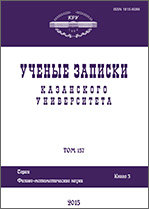|
|
Kazanskii Gosudarstvennyi Universitet. Uchenye Zapiski. Seriya Fiziko-Matematichaskie Nauki, 2005, Volume 147, Book 2, Pages 68–79
(Mi uzku498)
|
 |
|
 |
Pulsed field gradient NMR study of the translational mobility in porous media: restricted diffusion, internal magnetic fields, flows and molecular exchange
V. D. Skirda, A. R. Mutina, R. V. Arkhipov
Kazan State University
Abstract:
The basic principles of the pulse field gradient NMR (PFG NMR)
study of porous media are discussed in the article. It is shown
that self-diffusion coefficient of the fluid molecules confined in
the porous media dependence on the diffusion time includes direct
information about restriction sizes within porous matrix. The
question of the inducted in the porous media internal magnetic
fields is discussed from the point of view of the required using
of the high pulse field gradients in order to avoid experimental
data distortion.
It is shown that information about porous media structure and
fluid localization could be obtained by the study of the diffusion
decay in the internal field gradients (without applying pulse
field gradient). The experiment where one can study dependence of
the stimulated echo amplitude on the time interval between first
and second RF pulses ($\tau$-scanning) with different diffusion
times is offered to get information about internal magnetic field
gradient (IMFG) distribution. The offered approach of data
analysis allows to evaluate IMFG values and width of their
distribution. Particularly, is shown the in the partially
saturated porous media the information about internal magnetic
field gradients allows to conclude about fluid localization in the
porous matrix.
One of the topical questions of the fluid filtration through the
porous media problem is the question of the “stagnant” zone
quantitative characterization. The possibilities of the PFG NMR
technique are demonstrated in the paper: registration of the fluid
molecules share in the “stagnant” zones, determination of the
characteristics of the molecular exchange between “stagnant”
zone molecules and molecules involved in the flow, etc.
PFG NMR possibilities to study exchange process between different
fluid phases in the porous media are discussed. Particularly, it
shown that the apparent population of the molecules in the
different “phases” dependence on the diffusion time allows one
to obtain information not only about average molecular life-time
in the phase, but also information about distribution function of
the life times.
Received: 13.10.2005
Citation:
V. D. Skirda, A. R. Mutina, R. V. Arkhipov, “Pulsed field gradient NMR study of the translational mobility in porous media: restricted diffusion, internal magnetic fields, flows and molecular exchange”, Kazan. Gos. Univ. Uchen. Zap. Ser. Fiz.-Mat. Nauki, 147, no. 2, Kazan University, Kazan, 2005, 68–79
Linking options:
https://www.mathnet.ru/eng/uzku498 https://www.mathnet.ru/eng/uzku/v147/i2/p68
|

| Statistics & downloads: |
| Abstract page: | 309 | | Full-text PDF : | 92 | | References: | 44 |
|




 Contact us:
Contact us: Terms of Use
Terms of Use
 Registration to the website
Registration to the website Logotypes
Logotypes








 Citation in format
Citation in format 